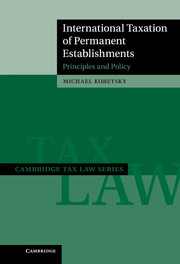Book contents
- Frontmatter
- Contents
- Abbreviations
- 1 Introduction
- 2 International taxation: policy and law
- 3 Some shortcomings of the tax treaty system
- 4 History of tax treaties and the permanent establishment concept
- 5 The role of the OECD Model Tax Treaty and Commentary
- 6 Defining the personality of permanent establishments under former Article 7 and the pre-2008 Commentary and the 2008 Commentary
- 7 Intra-bank loans under the pre-2008 Commentary and 1984 Report
- 8 Intra-bank interest under the 2008 Report
- 9 Business restructuring involving permanent establishments and the OECD transfer pricing methods
- 10 New Article 7 of the OECD Model and Commentary
- 11 Unitary taxation
- 12 Conclusion
- Bibliography
- Index
10 - New Article 7 of the OECD Model and Commentary
Published online by Cambridge University Press: 07 September 2011
- Frontmatter
- Contents
- Abbreviations
- 1 Introduction
- 2 International taxation: policy and law
- 3 Some shortcomings of the tax treaty system
- 4 History of tax treaties and the permanent establishment concept
- 5 The role of the OECD Model Tax Treaty and Commentary
- 6 Defining the personality of permanent establishments under former Article 7 and the pre-2008 Commentary and the 2008 Commentary
- 7 Intra-bank loans under the pre-2008 Commentary and 1984 Report
- 8 Intra-bank interest under the 2008 Report
- 9 Business restructuring involving permanent establishments and the OECD transfer pricing methods
- 10 New Article 7 of the OECD Model and Commentary
- 11 Unitary taxation
- 12 Conclusion
- Bibliography
- Index
Summary
Introduction
In 2008, the OECD published the 2008 Report which established the authorized OECD approach for determining the profits that are attributable to permanent establishments under Article 7 in light of modern multinationals. The 2008 Report is based on the principle of applying by analogy the guidance in the Transfer Pricing Guidelines for the purposes of attributing profits to permanent establishments. Moreover, the 2008 Report claimed that there is broad consensus within OECD countries that the principles in the 2008 Report are better than the approach for attributing profits to permanent establishments expressed in the pre-2008 Commentary on former Article 7. The approach developed by the OECD in the 2008 Report was not restricted by the original intent of former Article 7, or by any historical practice and interpretation of former Article 7, as the OECD acknowledged that prior to the publication of the 2008 Report there was no consensus interpretation of former Article 7 in OECD countries.
The OECD claimed in the 2008 Report that the best way to provide tax authorities and taxpayers with certainty on attributing profits to permanent establishments is to replace former Article 7 with a new version of Article 7 which reflects the principles in the 2008 Report. The new version of Article 7 was adopted in 2010 and at the same time the OECD adopted and published a revised version of the 2008 Report, the 2010 Report, ‘to ensure that the conclusions of that report could be read harmoniously with the new wording and modified numbering’ of the new Article 7. The conclusions in the 2010 Report are identical to those in the 2008 Report, but the 2010 Report reflects the drafting of new Article 7. New Article 7 reflects the principles adopted in the 2010 Report and ‘must be interpreted in light of the guidance contained in it’. The aim of the OECD is to prevent the past interpretations of former Article 7 from being applied to the new provision.
- Type
- Chapter
- Information
- International Taxation of Permanent EstablishmentsPrinciples and Policy, pp. 351 - 392Publisher: Cambridge University PressPrint publication year: 2011



